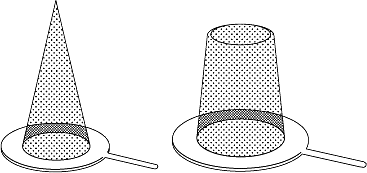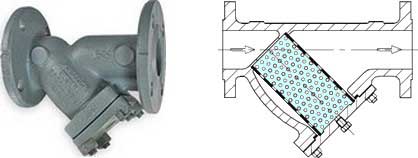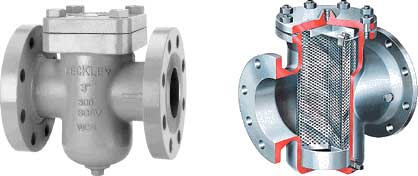Closed Vessel with cleanable Screen Element!
What is the function of a Strainer..
Strainers are important components of piping systems to protect equipment from potential damage due to dirt and other particles that may be carried by the process fluid.
During system start-up and flushing, Strainers may be placed upstream of pumps to protect them from construction debris that may have been left in the pipe. The figures here below depicts typical start-up Strainers. Permanent Strainers may be installed upstream of control valves, traps, and instrutments to protect them from corrosion products that may become dislodged and carried throughout the piping system.
 Typical Start-Up Strainers
Typical Start-Up Strainers
Centrifugal and reciprocating pumps handling material containing solids should have permanent Strainers provided in the suction lines to the pump or in the vessel from which the pump takes suction. The free area of such Strainers should be not less than three times the cross-sectional area of the suction line. The location of permanent Strainers (as contrasted to the temporary cone type which is installed at a flanged joint) also merits attention.
Y-Type Strainer
This product is designed for remove foreign matter from pipe lines and provides protection for pumps, meters, valves, and other similar mechanical equipment, which is called as Strainer. "Y" Type Strainers are named after their shape and normally used for course filtration. But with large filtration area can be used with fine mesh also. The Strainer improves the clearance in the medium, and prolongs the life of valves; protect expensive pumps, meters and other equipments. It is suitable for water, Air, Gas, petroleum, steam and other fluids. A Y-strainer can be installed in either a horizontal or vertical position (Downward flow) with the screen elementpointing downward. This allows the strainer screen to collect material in the strainer at the lowest point of the screen.
 Typical Y-Type Strainer
Typical Y-Type Strainer
Basket Strainer
An official definition adopted by the Fluid Controls Institute is..
"A closed vessel with cleanable screen element designed to remove and retain foreign particles down to 0.001 inch diameter from various flowing fluids."
Note the term "foreign particles". Strainers do not necessarily remove only dirt. They take out material which is not wanted in the fluid and this can sometime be a valuable product which may be saved. Basket strainers are designed for installation in horizontal lines. They are commonly used for liquid service applications.
 Typical Basket Strainer
Typical Basket Strainer
Basket Strainers are generally used where high flow capacity is required. The basket Strainer is serviced by removing the cover, which yields access to the basket. Basket Strainers are also available in a duplex style which consists of two parallel basket Strainers and diverting valves, which permit diversion of the flow through one of the Strainer elements while the other element is being serviced-an essential feature where flow cannot be interrupted.
What's the difference between a Filter and a Strainer..
A filter is a device that removes particles from a given liquid or gas. It includes a disposable medium for removing particles of specified micron sizes.
Simply stated, a Strainer is also a filter; however, it uses a perforated plate or screen mesh to remove larger particles from a process stream. The major advantage of a Strainer is that it is reusable. There are three levels of straining a) coarse, b) medium, and c) fine.
Typical Strainer Opening
Some typical Strainer opening or mesh sizes are provided by the table below for various equipment. The mesh sizes (or openings) are the usual maximums for normal operation. These opening sizes vary with the application, but should not exceed the value recommended for the particular type of equipment. The available pressure differential usually determines the minimum clear opening for screens.
Mesh to Micron Conversion Chart
| U.S. Mesh | Inches | Microns | MM |
| 3 | 0.2650 | 6730 | 6.730 |
| 4 | 0.1870 | 4760 | 4.760 |
| 5 | 0.1570 | 4000 | 4.000 |
| 6 | 0.1320 | 3360 | 3.360 |
| 7 | 0.1110 | 2830 | 2.830 |
| 8 | 0.0937 | 2380 | 2.380 |
| 10 | 0.0787 | 2000 | 2.000 |
| 12 | 0.0661 | 1680 | 1.680 |
| 14 | 0.0555 | 1410 | 1.410 |
| 16 | 0.0469 | 1190 | 1.190 |
| 18 | 0.0394 | 1000 | 1.000 |
| 20 | 0.0331 | 841 | 0.841 |
| 25 | 0.0280 | 707 | 0.707 |
| 30 | 0.0232 | 595 | 0.595 |
| 35 | 0.0197 | 500 | 0.500 |
| 40 | 0.0165 | 400 | 0.400 |
| 45 | 0.0138 | 354 | 0.354 |
| 50 | 0.0117 | 297 | 0.297 |
| 60 | 0.0098 | 250 | 0.250 |
| 70 | 0.0083 | 210 | 0.210 |
| 80 | 0.0070 | 177 | 0.177 |
| 100 | 0.0059 | 149 | 0.149 |
| 120 | 0.0049 | 125 | 0.125 |
| 140 | 0.0041 | 105 | 0.105 |
| 170 | 0.0035 | 88 | 0.088 |
| 200 | 0.0029 | 74 | 0.074 |
| 230 | 0.0024 | 63 | 0.063 |
| 270 | 0.0021 | 53 | 0.053 |
| 325 | 0.0017 | 44 | 0.044 |
| 400 | 0.0015 | 37 | 0.037 |
Strainer Mesh Sizes and Microns
Strainer - What does mesh size mean.. Figuring out mesh sizes is simple. All you do is count the number of openings in one inch of screen (in the United States, anyway.) The number of openings is the mesh size. So a 4-mesh screen means there are four little squares across one linear inch of screen. A 100-mesh screen has 100 openings, and so on. As the number describing the mesh size increases, the size of the particles decreases. Higher numbers equal finer material. Mesh size is not a precise measurement of particle size.
Strainer - What do the minus (-) and plus (+) plus signs mean when describing mesh sizes.. Here's a simple example of how they work. -200-mesh would mean that all particles smaller than 200-mesh would pass through. +200 mesh means that all the particles 200-mesh or larger are retained.
Strainer - How fine do screens get.. That depends on the wire thickness. If you think about it, the finer the weave, the closer the wires get together, eventually leaving no space between them at all. For this reason, beyond 325-mesh particle size is usually described in microns.
Strainer - What is a micron.. A micron is another measurement of particle size. A micron is one-millionth of a meter or one twenty-five thousandth of an inch.
Installation
Carefully check all machined surfaces to make sure they are free of defects, and the inside of the strainer is free of foreign objects. All strainers should be installed with the arrow on the strainer body pointing in the direction of flow. For installation of threaded strainers an appropriate sealant should be used on the threads. For the installation of flanged strainers the flanged bolting should be tightened gradually going back and forth in a clockwise rotation until all bolts are tight. The system can now be pressurized gradually while checking for any leakage around all connections. If leakage occurs, depressurize the system and start the installation procedure over.
Materials voor Strainers
The material for the Strainer body (including bolting) should be equal to the material specified for the valves in the same service. The screen material generally should be the same as the valve trim (stainless steel for most services).
Permanent Strainers should have baskets that can be flushed clean during operation or easily removed for cleaning. If considerable clogging of Strainers is anticipated the Strainers should be of the self-cleaning or the duplex type to permit continual flow of clean liquid.
Maintenance
Warning.. Before the removal or loosening of any bushing, cap, plug or cover on a strainer, extreme caution should be exercised to ensure there is zero pounds pressure in the system. Only after the system has been depressurized, should the strainer be drained for service.
Service on a pressurized Strainer can cause serious injury and/or property damage.
A Y-strainer screen can be cleaned by removing the plug in the bushing, cap or bolted cover allowing the strainer to drain the loose material inside the screen. If a blow-off valve is connected to the strainer it can be opened to achieve the same result as the above. The Y-strainer screen can also be cleaned by removing the bushing, cap or cover to access the screen element.
Basket strainers with a closed bottom basket can be cleaned by removing the cap or cover and pulling out the basket screen for service. If the strainer screen is bottomless the blow-off plug can be removed allowing it to be drained and cleaned like a Y-strainer.
Care should be taken in cleaning screens. After removing a screen, it should be soaked in a cleaning solution or cleaned by using a brush. Do not allow trapped material in the screen to harden, as it will be difficult to remove. A regular cleaning schedule is recommended to avoid screens from becoming clogged.
A pressure gauge installed before and after a strainer will indicate a pressure loss due to clogging. This can help in establishing a maintenance schedule for cleaning the strainer screen. Extra screens can useful in keeping the system operating during the cleaning process.